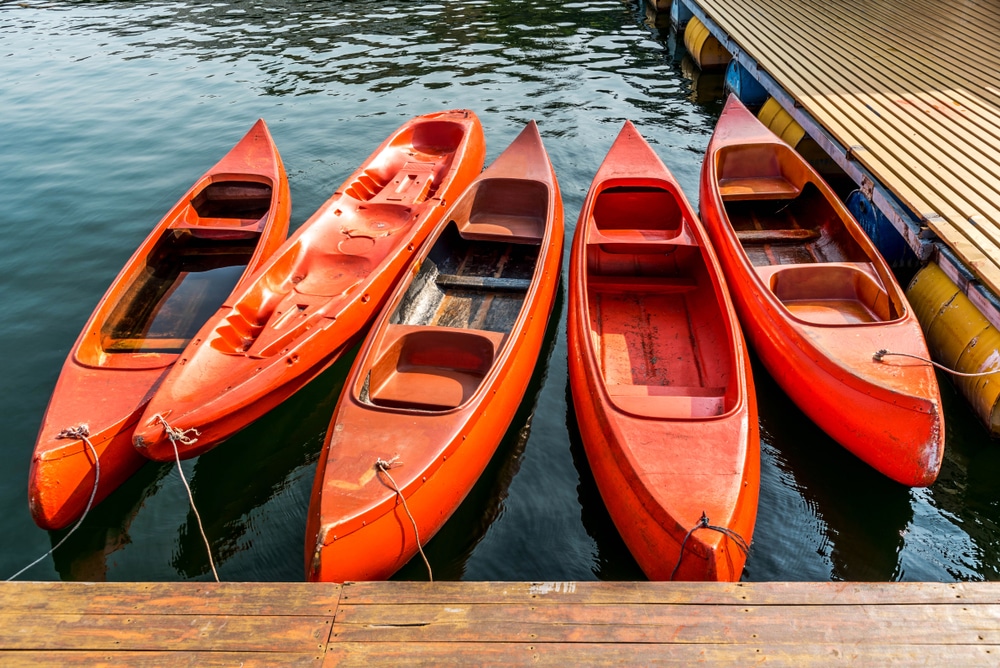Table of Contents
Kayaks and canoes are two kinds of boats widely used in various water excursions. Both kayaks and canoes are different in numerous aspects, providing unique experiences and having other characteristics that suit various water conditions and user preferences. While both are popular vessels for exploring lakes, rivers, and oceans, they are distinct in their designs, paddling techniques, and overall usage. Therefore, it is crucial to understand the difference between a kayak and a canoe to make an informed choice, considering your needs and demands. In this guide, we’ll break down the fundamental differences between kayaks and canoes to help you make an informed choice for your next water adventure.
History of Canoe and Kayak
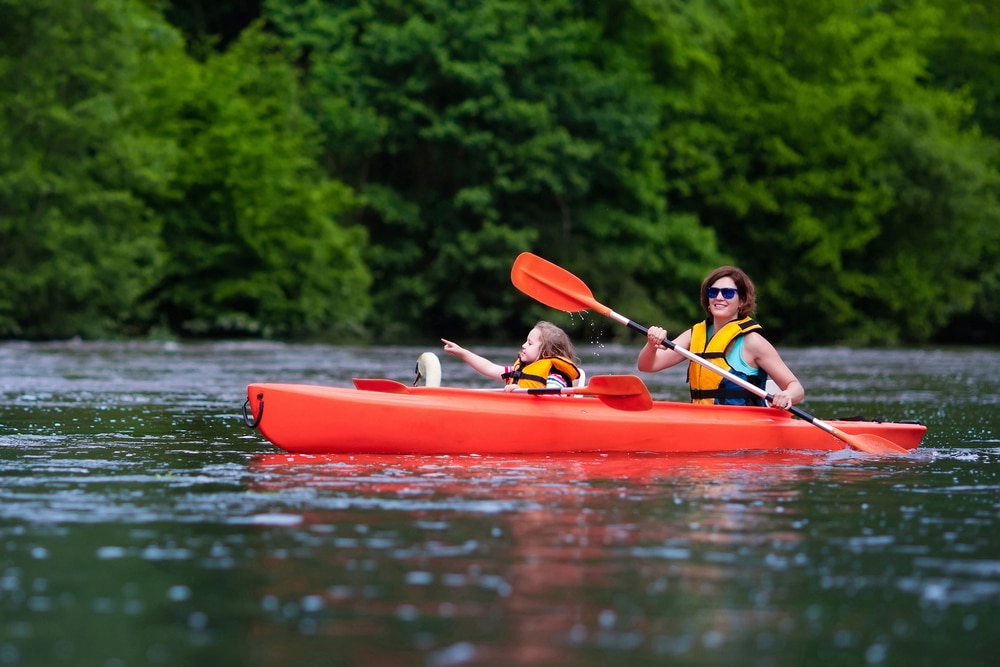
The history of canoes and kayaks is rich and diverse, with both boats having deep cultural and practical significance.
Canoes
For thousands of years, indigenous peoples have traveled the world in canoes. Native American cultures in North America used materials, including animal hides, cedar, and birch bark, to make canoes. These boats were necessary for trade, hunting, and transportation, allowing the discovery and colonization of large areas. Often made from hollowed-out tree trunks, canoes were equally crucial for fishing and travel throughout Oceania and Africa.
Kayaks
Conversely, Kayaks originate from the Inuit, Aleut, and Yupik peoples of the Arctic regions. The frames of these early kayaks were covered in sealskins or constructed from driftwood. They provided a stealthy and quick mode of transportation and were primarily used for hunting and fishing in the icy seas. The enclosed design of the kayak, with a small cockpit where the paddler sits, offered protection from the cold and waves, making them well-suited for the harsh Arctic environment.
Difference Between Kayak And Canoe

Design and Structure
- Canoes have an open design, typically featuring an open deck where the paddler sits or kneels. Because of their open design, canoes are perfect for recreational kayakers who like camping, picnics, and family adventures on serene lakes and rivers.
- On the other hand, Kayaks come in various designs, including sit-on-top kayaks, touring kayaks, and whitewater kayaks. Since they are stable and easy to escape, sit-on-top kayaks are especially well-liked by beginners and recreational paddlers.
Paddling Techniques
- One of the main differences between kayaks and boats is the kind of paddle used. The paddler uses a single-bladed paddle to move the canoe ahead. This requires alternating strokes on either side of the canoe, which can be more physically demanding and require a good technique to maintain a straight course.
- In contrast, a double-bladed paddle is used when kayaking. To create a more continuous and effective paddling action, the paddler alternates strokes on either side of the kayak without changing hands.
Seating Position
- Another significant difference between a kayak and a canoe is the seating arrangement. In a canoe, the paddler sits on a bench-like seat or kneels on the boat’s floor. Although this elevated seating position can be less stable in turbulent waters, it offers a superb vantage point for touring and fishing.
- Paddling a kayak usually involves sitting low in the craft and extending one’s legs. This reduced center of gravity improves control and stability, particularly in difficult circumstances. Compared to regular kayaks, sit-on-top kayaks offer a higher seating position, which some paddlers find more comfortable.
Stability and Control
- Both canoes and kayaks are designed with stability in mind. Because of their superior secondary stability, kayaks work better in rough conditions and when leaning on their sides. This is because of their more streamlined design and lower center of gravity.
- With their wider and more open design, canoes provide excellent primary stability, making them more stable on calm waters and easier for beginners to balance in.
Speed and Maneuverability
- Kayaks have the advantage when it comes to speed. Their sleek, narrow design and double-bladed paddle allow for incredible speed and agility. Because of this, kayaks are perfect for sea kayaking, whitewater kayaking, and touring.
- While generally slower, canoes offer better maneuverability in tight spaces, such as lakes, rivers, and calm water bodies. They are ideal for adventures outdoors, including fishing, paddling for fun, and taking family vacations.
Load Capacity and Usage
- Canoes have a reputation for having a higher carrying capacity. They are appropriate for extended excursions and camping outings since they can hold more gear. This is especially useful for those who need to transport heavy equipment or travel with multiple people.
- Kayaks include distinct compartments and hatches for storage, which makes them useful for shorter journeys and particular activities even though their cargo space is limited.
Exploring Different Types of Kayaks
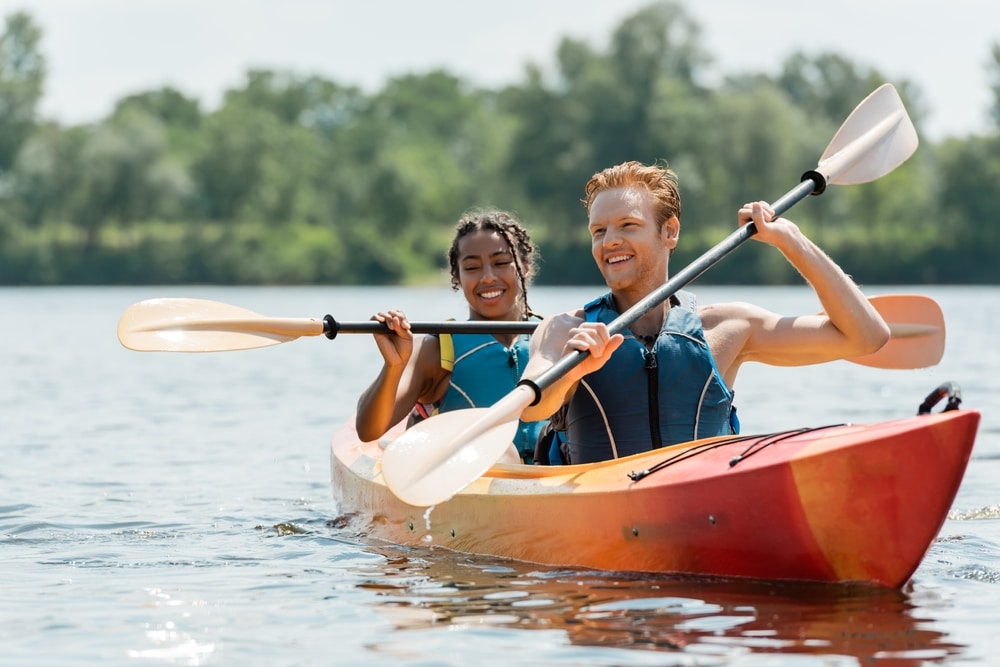
As mentioned earlier, a kayak comes in various designs tailored for specific activities. Let’s explore the many kinds of kayaks and their special characteristics in more detail.
Sit-on-Top Kayaks
These kayaks are stable and easy to use. Instead of sitting in a cockpit, the paddler sits atop the kayak. Because of their simple structure, kayaks are a popular option for both recreational and beginner paddlers. Fishing enthusiasts also prefer sit-on-top kayaks due to their comfortable seating posture and convenient access to equipment.
Touring Kayaks
Built for efficiency and speed, touring kayaks are designed for long-distance travel. Their boats are usually longer and narrower, so they can move through the water more efficiently. These kayaks are perfect for extended and multi-day journeys since they frequently have storage compartments for transporting goods. The enclosed cockpit offers protection from the elements, enhancing comfort during extended paddling sessions.
Whitewater Kayaks
Specifically designed for navigating rapids and rough waters, whitewater kayaks are shorter and more maneuverable than other kayaks. Their durable design allows them to endure pressure and hits from quickly flowing water. In rough conditions, the paddler’s low position within the kayak allows for improved control and stability.
Fishing Kayaks
Fishing kayaks are designed with fishermen in mind, and they come with features like rod holders, gear storage, and cozy seats. These kayaks are stable and have a large capacity to hold fishing equipment. Certain fishing kayaks are made to be sit-on-top variants, which facilitate mobility and equipment access.
Discover the best fishing kayak for yourself among the 9 Best Fishing Kayaks to enjoy your favorite recreational sport.
Inflatable Kayaks
Inflatable kayaks offer the convenience of portability and easy storage. They can be deflated for storage and transportation and reinflated as needed. Modern inflatable kayaks are made to be solid and stable, fit for a range of water conditions, but still lightweight and portable. Explore the 5 Best Inflatable Kayaks to add convenience and comfort to your journeys.
Tandem Kayaks
Two paddlers can fit inside a tandem kayak’s design. They are great for couples, friends, or family members who want to paddle together. These kayaks are available in sit-on-top and traditional styles, providing versatility for various paddling activities. Get Your Hands on the Best Tandem Kayaks for Fun Sea Adventures.
Exploring Different Types of Canoes
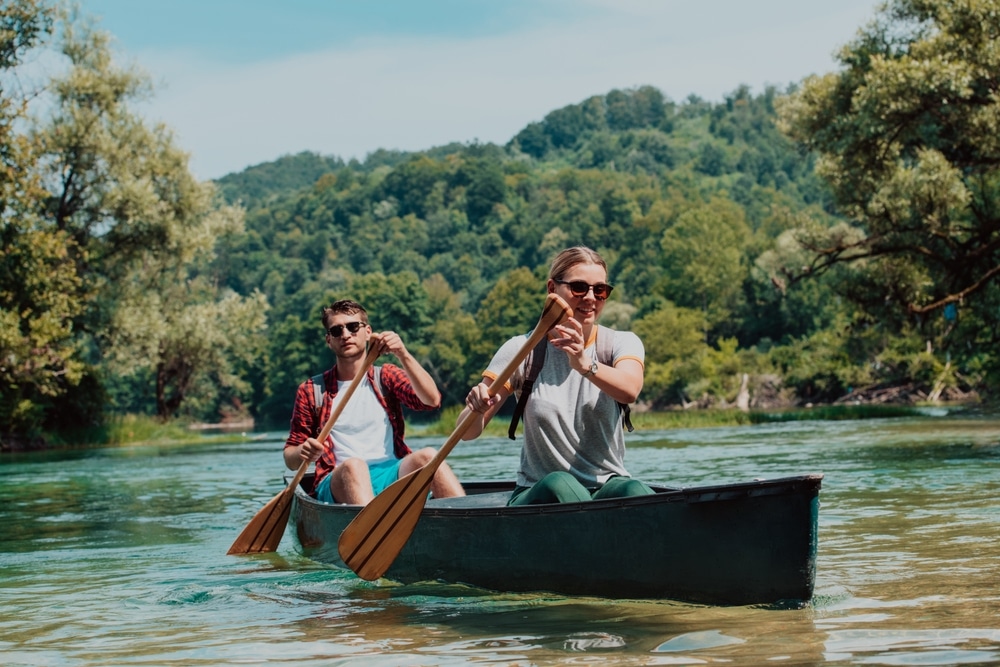
Canoe designs vary, each appropriate for a particular use and water conditions.
Recreational canoes
Recreational canoes are the most popular kind of canoe, which are made for flatwater paddling on lakes and leisurely-moving rivers. Because they are spacious and durable, recreational canoes are perfect for family get-togethers, picnics, and camping excursions. They provide an enjoyable and comfortable way to paddle. Choose the Best Recreational Canoes for comfortable and enjoyable journeys.
Whitewater Canoe
With their sturdy and long-lasting build, they are designed to withstand the difficulties posed by rapids and turbulent waters. Because of their increased maneuverability, paddlers can easily navigate through rough conditions.
Racing Canoes
Designed for competition paddling, these canoes are lightweight and streamlined for maximum speed and efficiency. They are made to be as fast and efficient as possible and are used in various paddling competitions.
Fishing Canoes
Similar to fishing kayaks, fishing canoes have features that cater to anglers. They provide stability and room to store equipment and fishing gear. The open deck design makes accessing and managing gear while fishing easy.
Pros and Cons of Kayaks and Canoes
Each kayak and canoe has pros and cons that vary depending on the intended use, the water’s condition, and the user’s preferences. Here, we examine the benefits and drawbacks of each to help you in making an informed decision.
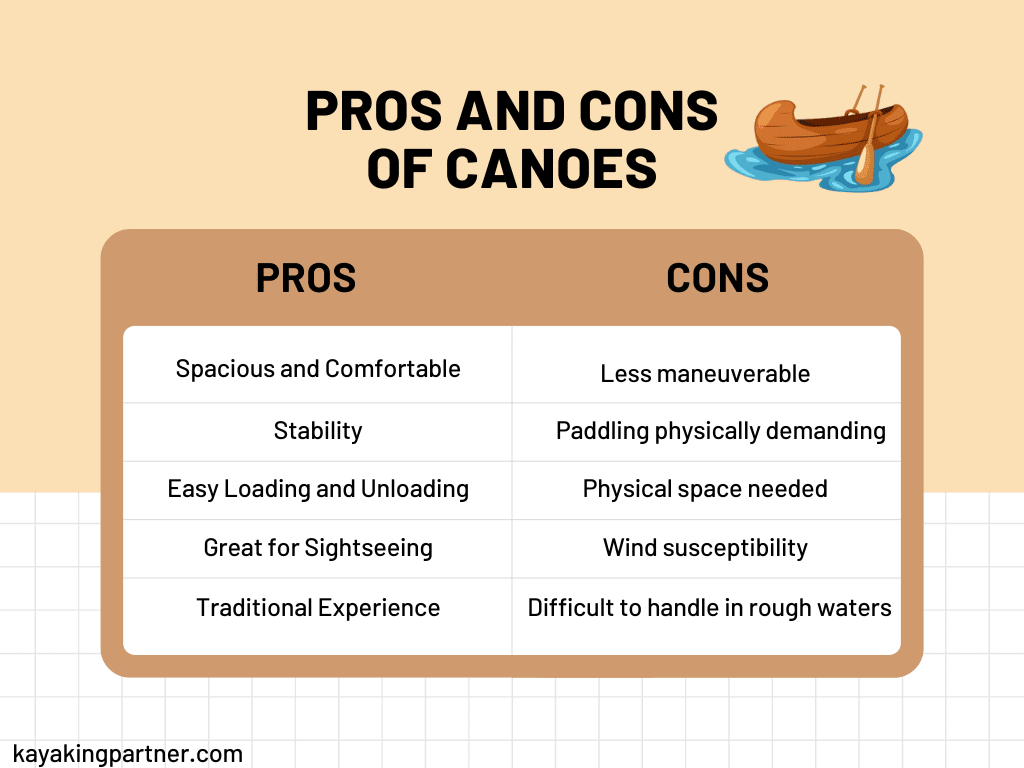
Pros of Canoes
Spacious and Comfortable
Canoes have an open design, providing plenty of room for passengers and gear. This makes them perfect for camping vacations, family get-togethers, and carrying gear.
Stability
Canoes are better for beginners and calm-water sports since they are typically wider and more stable than kayaks.
Easy Loading and Unloading
The open deck design of canoes makes it easy to load and unload gear, passengers, and pets.
Great for Sightseeing
The elevated seating position in a canoe provides a better vantage point for observing the surroundings and wildlife.
Traditional Experience
Many people find that paddling with a single-bladed paddle is a delightful and fulfilling experience.
Cons Of Canoes
- Canoes are generally less maneuverable than kayaks, particularly in rough or swift-moving water. They require more time and skill to navigate.
- Paddling a canoe with a single-bladed paddle can be more physically demanding, especially over long distances.
- A canoe’s bigger profile can increase its wind susceptibility, making paddling in windy situations more difficult.
- Because of their open design and stability problems, canoes can be difficult to handle in rough waters, such as rapids or open seas.
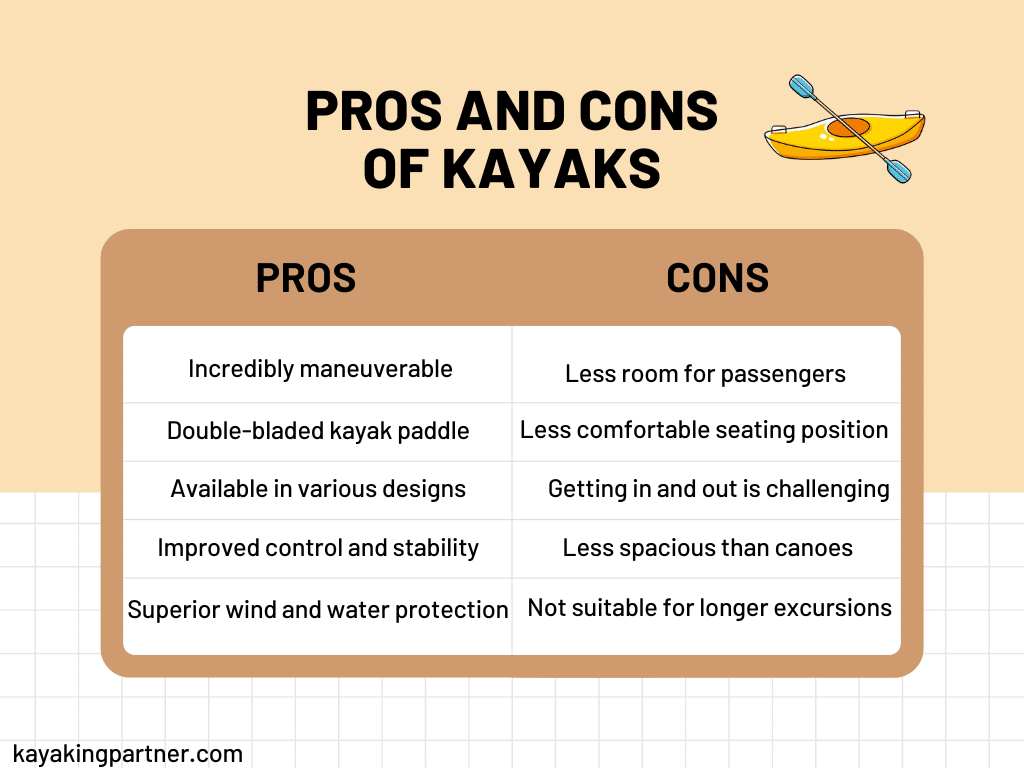
Pros of Kayaks
Maneuverability
Kayaks are incredibly maneuverable and efficient in the water because of their enclosed design and double-blade paddles. They are perfect for traversing narrow locations and challenging terrain.
Speed and Efficiency
A double-bladed kayak paddle, which enables continuous and effective strokes, makes long-distance paddling while maintaining speed more accessible.
Versatility
Kayaks are available in various designs, each appropriate for different activities and water conditions. These designs include sit-on-top kayaks, touring kayaks, whitewater kayaks, and inflatable kayaks.
Stability in Rough Waters
A kayak’s lower seating position lowers its center of gravity, which improves control and stability in rapid or turbulent waters.
Protection from the Elements
Traditional kayaks’ enclosed shape provides superior wind and water protection, keeping the paddler dry and comfortable.
Cons Of Kayaks
- Compared to canoes, kayaks typically have less room for passengers and equipment. This can be a drawback for travels with the whole family or longer excursions requiring a lot of gear.
- Some paddlers find the low seating position in a kayak less comfortable, especially during long paddling sessions. Sit-on-top kayaks can offer more comfort but may still be less spacious than canoes.
- Getting in and out of a traditional kayak can be more challenging than a canoe, especially for beginners or those with limited mobility.
Conclusion
In conclusion, the two distinct types of boats, kayak, and canoe, offer unique benefits and experiences for water enthusiasts. Understanding the differences in design, paddling techniques, seating positions, types, and uses can help you decide which type of boat best suits your needs. Despite the differences, the two kinds of boats provide endless opportunities for adventure and enjoyment on the water to the best of their abilities. Also, both kayaks and canoes have distinct advantages and disadvantages. Whether you choose a canoe or a kayak, both types of boats offer unique and enjoyable ways to explore and experience the water.
